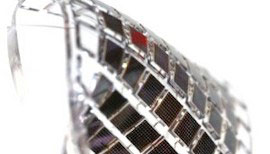mc10 developing flexible high-efficiency solar for military applications
 Late last week, Cambridge-based mc10 Inc. won an award from the U.S. Army’s U.S. Army Natick Soldier Research, Development & Engineering Center (NSRDEC) to develop flexible, high-efficiency photovoltaics that could be integrated into or onto soldiers’ uniforms and or helmets. The devices could help reduce the amount of batteries that soldiers must carry as the amount of electronic devices they must carry continues to increase.
Late last week, Cambridge-based mc10 Inc. won an award from the U.S. Army’s U.S. Army Natick Soldier Research, Development & Engineering Center (NSRDEC) to develop flexible, high-efficiency photovoltaics that could be integrated into or onto soldiers’ uniforms and or helmets. The devices could help reduce the amount of batteries that soldiers must carry as the amount of electronic devices they must carry continues to increase.
While it’s far the first time the Army has looked to introduce flexible photovoltaics into remote devices, its a unique application because mc10 is working with high-efficiency gallium arsenide (GaAs) PV cells rather than the other flexible PV cells the Army has looked to for remote applications in the past. “We are developing a module that packages arrays of flexible, thin-film GaAs cells, that are connected by stretchable interconnects so that the overall system will be both flexible and stretchable,” said mc10 Cofounder Ben Schlatka.
Other flexible PV technologies the Army has used or is using include amorphous silicon and Copper Indium gallium selenide (CIGS). However both of those are much less efficient than GaAS PV, which takes advantage of multiple layers of materials designed to pull photons from different spectrums of sunlight. They’re also not as flexible as the devices mc10 is developing since they’re suited more for apparatuses that fold out like a portable array or a shade structure.
These devices will need to work in a more active, wearable role. “A wearable application has an even higher standard for flexibility and ruggedness than a tent or a tarp, which is mostly planar with only a little bending necessary,” said Schlatka. “Once you wrap these systems around a helmet or a rucksack it has to wrap around tighter curves and will be flexing a lot more. It will also probably be exposed to a lot more wear and tear. Once we meet this higher standard and maintain an acceptable solar conversion efficiency at the total system level, then we expect it will be very appropriate to the less demanding applications. That will make it an all-around better solution for nearly any field use case,” he said.
While the company is developing these devices for active use in the field they’re not taking advantage of the fact that most GaAs PV cells are being developed for concentrating photovoltaics. “Concentrators add efficiency, but they also add volume and mass that is undesirable for wearable gear. Concentrated photovoltaic applications tend to be rigid and planar and are less attractive for mounting to helmets and rucksacks,” Schlatka said.



